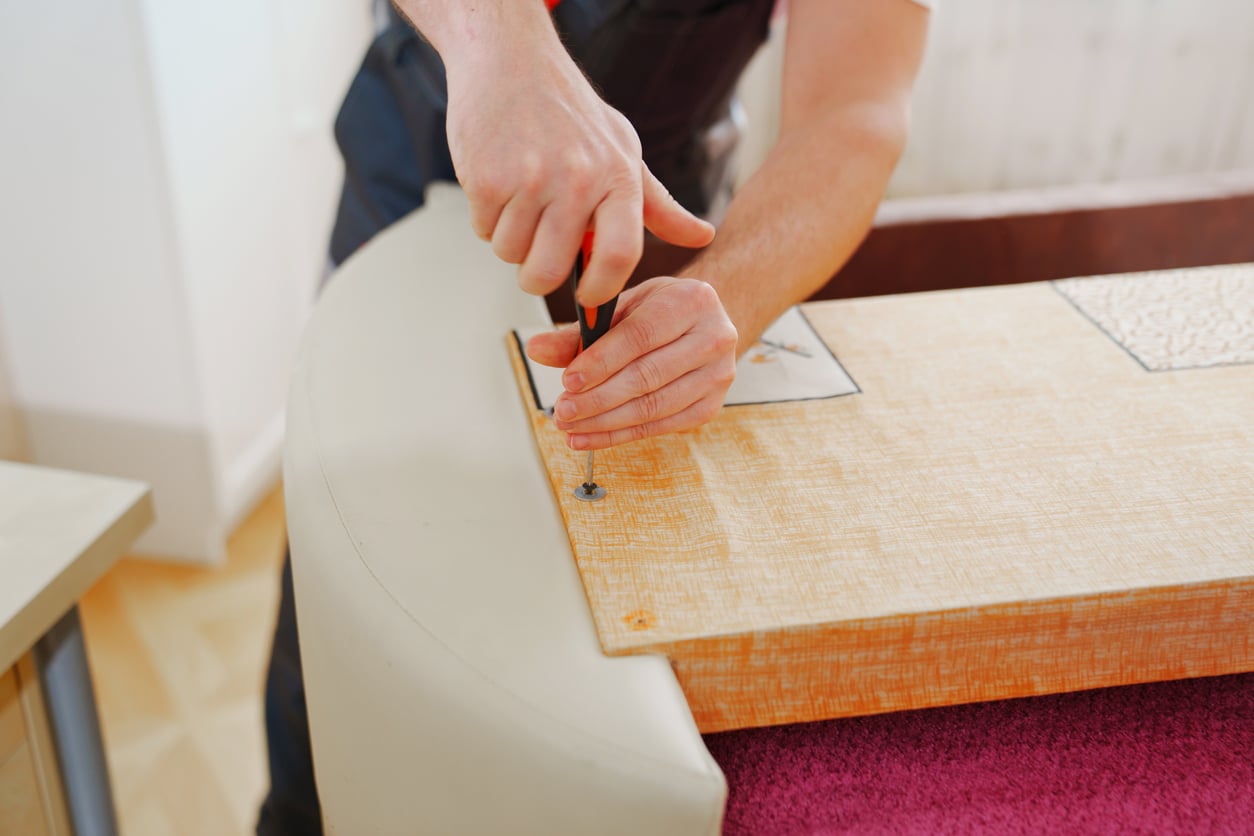Whether it’s a dent in your kitchen table, a scratch in your bed frame, or a broken leg on your favorite chair, furniture damage is one of the more stressful parts of moving. Fortunately, with the right steps, this headache can be avoidable.
The easiest and most efficient way to prevent furniture damage while moving is to hire a professional service to handle those logistics for you. But we get it: sometimes you just want to do the work yourself.
Consider this your guide on how to protect furniture when moving — from the supplies to step-by-step instructions — so that everything arrives at your new home all in one piece.
Gather the Packing Supplies
Before we jump into the finer points of how to protect furniture during a DIY move, let’s make sure you have the right supplies and materials on hand.
Here’s a quick rundown of what you’ll need for a smooth, damage-free process:
Hand tool kit: This should contain screwdrivers, wrenches, pliers, and other tools for disassembly.
Ziploc bags: Store nails, screws, nuts, bolts, or other hardware in resealable bags.
Moving blankets: Cushion large furniture pieces like dressers or tables from scuffs, dents, scratches, or other damage in transit.
Bubble wrap: Protect the most delicate furniture parts like glass surfaces, mirrors, chair legs, and ornate accents or inlays.
Painter’s tape: Secure the bubble wrap or moving blankets without adhesive residue.
Corner protectors: Protect the fragile corners of desks, tables, cabinets, or dressers from chips and other breakage.
Cling wrap: Prevent drawers or cabinet doors from sliding out of place in transit.
Upholstery covers: Shields fabric or leather on couches and other upholstered furniture from dirt, tears, snags, or moisture in transit.
Furniture sliders: Transport heavy furniture across floors and out of the house without scratching the wood or tile surfaces.
Dolly or hand truck: Wheel tall, vertical furniture pieces like dressers or cabinets out of the house without causing physical strain.
Tie-down straps: Secure heavy or delicate furniture pieces in the moving truck, so they won’t shift or slide into other items in transit.
Corrugated panels: These act as a barrier between furniture surfaces and boxes or shelves if you have to stack items inside the truck.

How to Disassemble Furniture
Now it’s time to roll up your sleeves and start the disassembly process. Not all furniture needs to be taken apart before a move, but many of the heavier, bulkier items require disassembly to lift and transport them with ease.
Certain fragile pieces such as chair or table legs should also be removed from their bases for extra protection.
Here are our pros’ best tips for furniture disassembly:
Make sure you have the right tools
You’ll need a screwdriver, hex wrench, pliers, and a hammer or rubber mallet in order to safely take apart large furniture items without professional assistance.
Take photos before the disassembly
Snap clear photos of each furniture item while it’s still in one piece. This will make it easier to reassemble complex furniture items with numerous parts — like bed frames, desks, or shelving units — in your new home.
Remove any loose or delicate parts
Unscrew detachable legs from their bases and remove any fragile surfaces or inserts, cushions, shelves, loose drawers, or cabinet doors. You can also use cling wrap to secure the drawers and cabinet doors in place if that feels easier.
Disassemble one section at a time
Work in batches to carefully disassemble large, heavy furniture pieces. Here’s a rundown of how best to do this for various types of furniture:
Beds
Remove the mattress and box spring, then place them inside a mattress bag. Next, unscrew the headboard, footboard, slats, and rails to take apart the bed frame.
Tables
Flip the table upside down on a carpeted floor or another soft, non-slip surface. Then, use a screwdriver or wrench to remove each of the legs.
Couches
Turn the couch on its back to unscrew the legs, then detach the armrest and back. If you have a modular couch, split it into two halves for easier transport.
Store all the hardware in Ziploc bags
Keep the nails, screws, nuts, bolts, or other small hardware parts with the piece of furniture they correspond with. You can do this by storing the hardware in releasable bags and taping (with blue painter’s tape) these baggies to the furniture it corresponds to. Just in case they get detached, make sure to label each bag.
Wrap each furniture piece securely
Bundle durable metal or wooden furniture parts in moving blankets and reinforce the edges with corner protectors. Use bubble wrap to cushion more delicate pieces such as glass or mirror shelves and inserts or chair and table legs. Next, secure each bundle with painter’s tape, then label the tape, “Fragile — handle with care.”

How to Wrap Furniture for Moving
What is the best way to wrap furniture? We briefly touched on this above — now let’s dive into the details.
Here’s how to wrap furniture for moving, based on the shape, size, heft, and type of each item. Follow these steps carefully to minimize the risk of damage in transit.
How to wrap a bed for moving
Cover large, flat pieces like the headboard or footboard with moving blankets. Bundle the rails with bubble wrap and use painter’s tape to secure them. Stack the frame slats on top of each other and secure them with cling wrap.
How to wrap a table for moving
Cover the table top with moving blankets, then reinforce the edges with corner protectors if your table is either square or rectangular. If the legs detach, bundle them together with bubble wrap and use painters tape to secure them.
How to wrap chairs for moving
Cover each chair frame with moving blankets, and use a small upholstery cover or cling wrap to shield the cushion from dirt, tears, snags, or moisture. If the legs detach, bundle them with bubble wrap and use painter’s tape to secure them.
How to protect a couch when moving
Cover the cushions with cling wrap or a small upholstery cover to shield them from dirt, tears, snags, or moisture.
If the legs and armrests detach, bundle them with bubble wrap and use painters tape to secure them.
If the back and other modular pieces detach, wrap them separately with moving blankets.
If the couch doesn’t come apart, cover the frame with moving blankets or a large upholstery cover.
How to pack a dresser for moving
Remove the drawers, then protect them with cling wrap (or leave the drawers in place and use cling wrap to secure them to the dresser). Cover the frame with moving blankets, then reinforce the edges with corner protectors.
How to protect wooden furniture during a move
Wrap miscellaneous wooden pieces (e.g., desks, coffee tables, nightstands, bookcases, cabinets, or shelving units) in moving blankets, as you would with other large furniture items.
Then, use cling wrap to secure any loose drawers or doors in place and reinforce the edges with corner protectors. If there are any detachable parts, bundle them with bubble wrap and use painter’s tape to secure them.
More Pro Packing Videos:
How to Safely Move Furniture
Once your furniture is all packed, the next step is transporting it. So, how do you move furniture without damaging it? The trick is to be efficient but methodical. Don’t rush the process — take your time, be careful not to overload yourself, and enlist an extra pair of hands if possible.
Here’s how to prevent furniture damage while moving each item out to the truck.
Before you start transporting, take measurements. Measure the dimensions of hallways, door frames, staircases, and elevators (if necessary), then compare these measurements to the dimensions of your largest furniture piece. Unscrew doors from their hinges temporarily to allow for more clearance if you need it.
Clear a safe, unobstructed path to walk through. Remove all rugs, shoes, or clutter from this path and turn on all the lights for maximum visibility. If the floor feels slick, use cardboard sheets or non-slip runners for protection.
Use furniture sliders to transport large, bulky frames. These plastic or felt discs can easily fit under the base of a couch or other heavy furniture items, so you can slide them across wood or tile floors without scratching the surface.
Move tall, vertical furniture pieces with a dolly. Not sure how to move a dresser, filing cabinet, bookcase, or other similarly shaped items? Secure them to a dolly with tie-down straps, then wheel them directly out to the truck.
If you have to lift a piece of furniture, use the right technique. Hold the furniture item at the sturdiest part of its base, keeping it close to your body. Next, once you have a firm grip, lift with your legs — not your back — to lower the risk of strain. Don’t twist or lean at the torso. And watch your step to avoid falls or other injuries.
Take it slow and communicate with your helper. If another person is there to assist, coordinate your movements with them. Simple instructions like, “Tilt this side to the left,” “be careful around this corner,” or “get ready to lower,” will make it easier for both of you to navigate. Take short breathers if you need and remember not to rush — especially on stairs or in other tight, narrow spaces.
More Pro Packing Tips: |
How to Load Furniture in a Truck or Container
You’ve made it out the door — now it’s time to load up the moving truck or container for transport. These loading best practices will show you how to prevent furniture damage while moving and streamline what can be a labor-intensive process.
Get the truck or container ready for its haul. Lay thick cardboard sheets or moving blankets on the floor to create an extra layer or cushion and protection for your furniture. Then, lower the ramp and make sure it’s secure on the ground.
Load your heaviest furniture items first. Dressers, appliances, couches, large bed frames, mattresses and other bulky pieces should be near the back to help effectively distribute weight inside the truck or container. Stand them upright, flush to the wall or snugly next to each other in order to prevent shifting. Then, secure each furniture item to anchor hooks on the floor or sides using tie-down straps.
Load your lighter furniture items next. Once the largest furniture pieces are secure, move on to your chairs, tables, nightstands, bookcases, consoles, and other smaller items. As with the bulky furniture, stand them upright, flush to the wall (if there’s still room) or snugly next to each other in order to prevent shifting. Then, secure each furniture item to anchor hooks on the floor or sides using tie-down straps.
Fill in any space with miscellaneous items. Use seat cushions, pillows, boxes, and other light but durable items to close the gaps between your furniture pieces. This will ensure they can’t rattle around or get damaged in transit. Only stack boxes on top of the heaviest furniture that can handle extra weight.
Load your fragile or awkwardly shaped furniture items last. Tuck any mirrors, glass pieces, valuable artwork, or other delicate items vertically between mattresses and other secured furniture items. Next, load the bundles of detachable pieces such as bed frame rails or chair and table legs. Finish off with the awkwardly shaped items like floor lamps, then double check that nothing can move around in the truck or container.
How to Unload Furniture and Check for Damage
The truck has arrived at your new home, and you can start to settle into whatever this next chapter has in store. But of course, you have to unload the truck first. Here’s how to safely unload after the move and inspect each item for damage.
Measure the dimensions of your new place. Just like on the front end, it’s important to ensure all the furniture items can fit through your new home’s door frames, hallways, and staircases. Compare the dimensions of these areas to your largest furniture dimensions. Remove the doors from their hinges for extra clearance.
Clear a path to the front entry and through the halls. Open the doors that you’ll need access to while unloading, then make sure the path is clear of any clutter or debris. If the floor feels slick, use cardboard sheets or non-slip runners for protection.
Work from the front to the back of your moving truck. Start by unloading the items that are easiest to reach and lightest to carry. Transport these items to the rooms where they belong. Next, move on to the larger items near the back. Use a dolly or furniture sliders, so you won’t have to transport these items manually. If for some reason, you need to lift a heavy object, stabilize the load with moving straps.
Look your furniture over, then record any damage. Once inside, unwrap each piece of furniture (including the detachable parts) and quickly inspect it for damage. If you come across any, snap a clear photo and make a note of the item’s estimated value. You’ll need this documentation for insurance claims.

Prevent Furniture Damage with Colonial Van Lines
Would you rather leave protecting your furniture to the professionals? Colonial Van Lines is here to help! We can handle the furniture moving and all the other logistics of your move — from packing to transporting to unloading.
With over 50 years of experience as long-distance movers, our team of expertly trained movers will ensure your furniture (and everything else) arrives at your new home in one piece. Contact us for a free moving quote today!

